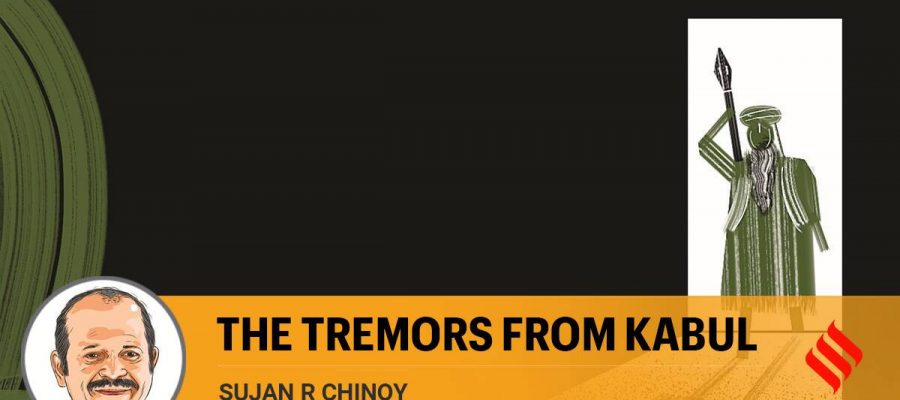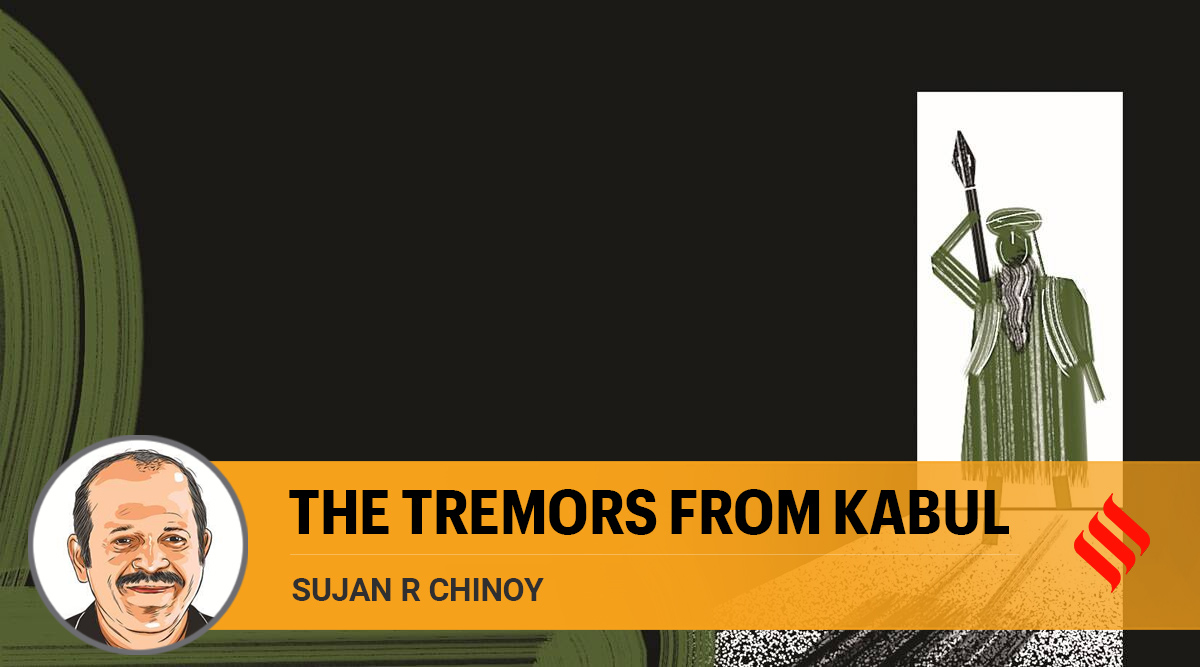Sujan R Chinoy writes: Taliban will have to show moderation if they wish to be accepted as a member of the global community.
The world over, television screens are full of images of the extraordinary takeover of Afghanistan by the Taliban. This time, the Taliban have done it even faster than in 1996. An unfolding humanitarian tragedy has engulfed the country.
Thousands of Afghan citizens are fleeing in an attempt to put distance between themselves and the Taliban. With neighbouring countries still averse to admitting refugees from Afghanistan through overland routes, air travel out of Kabul seems the only option.
Chilling images of stampedes at Kabul airport, including of people running alongside a US Air Force plane and desperate stowaways plummeting to their deaths have shaken the global conscience.
The Afghan government and its defence forces have completely collapsed. Key leaders have fled the country. In staying on, Hamid Karzai, Abdullah Abdullah and Gulbuddin Hekmatyar are perhaps banking on their personal networks.
The US has expended much treasure, and shed much blood, over the last two decades. The original trigger for the US military intervention in Afghanistan was the 9/11 attacks. The objective then was to eliminate the al Qaeda sanctuaries hosted by the Taliban. That goal was quickly attained, as was another one — the elimination of Osama Bin Laden in Abbottabad, Pakistan, in 2011.
The US was thereafter sucked into a vortex in which its mission oscillated between counter-terrorism and counter-insurgency. Even under four consecutive Presidents, US policy towards Afghanistan remained in flux. The military presence in Afghanistan has been questioned by the US political firmament for a decade. The US has long been searching for an honourable exit. Meanwhile, the trillions of dollars pouring into Afghanistan into development and reconstruction programmes had led to vested interests in the form of private security contractors, service providers and NGOs.
Today, the rise of China is the main geo-strategic threat for the US. In 2001, the US had taken its eye off the ball in diverting its attention to the global war on terror. Beginning with Afghanistan, it meandered through Iraq, Libya and Syria, with mixed results.
The US now regards China as its principal strategic competitor. The latter’s muscle-flexing in the East and South China Seas calls for a renewed effort by the US to protect its stakes. China’s recent ratcheting up of pressure on Taiwan has also sounded the alarm. The US can ill-afford the continued burden of a military presence in Afghanistan, that too of little avail, if it has to tackle China effectively in the Indo-Pacific in order to secure its interests.
China had shrewdly invited Taliban leader Mullah Abdul Ghani Baradar early on in an attempt to secure assurances that prevent Afghan territory from being used to host Uighur separatists.
In welcoming the latest developments, the spokesperson of the Chinese foreign ministry has expressed willingness to “continue to develop friendly and cooperative relations with Afghanistan”. The engagement with the Taliban may pay dividends. At the same time, China cannot be unmindful of the fact that the US, having rid itself of the albatross of Afghanistan from around its neck, will have better options and greater resources in dealing with China.
It should come as no surprise if a Taliban government in Afghanistan were to be friendly towards China and Pakistan. The new regime in
Kabul is likely to open the door to economic investments from China. At the geopolitical level, the BRI may well receive a boost, given China’s interests in connectivity that could straddle the region, from Pakistan to Iran.

At the multilateral level, the UN Security Council’s press statement issued on August 16 by India’s Permanent Representative, in his capacity as its rotational President, calls for “an immediate cessation of all hostilities and the establishment, through inclusive negotiations of a new Government that is united, inclusive and representative”.
In recognition of the hard-earned gains made over the last two decades, it also underscores the need for the continued participation of women in governance. The statement also expresses concern about the violation of human rights and international humanitarian law.
The Taliban juggernaut is endeavouring to project a more moderate image of itself to a global audience that has vivid memories of its draconian rule in the 1990s. By announcing that there would be no reprisals, the Taliban have sent out a signal to this effect. However, the world will need more than just words by way of evidence in the coming months. The Taliban cannot afford to alienate the global community through a repeat of its retrograde policies, particularly on matters concerning safe havens for terrorists and the rights of women and minorities.
Taking over a country by force is one thing but governing it effectively is quite another matter. Through the recent campaign, the Taliban revealed a proclivity for violence. They will now have to demonstrate a capacity for governance. They will have to show moderation if they wish to be accepted as a member of the global community and to retain the talent nurtured in recent years.
Maintaining the vastly improved communications network, energy infrastructure, hospitals and healthcare facilities, and efficiently running the many community development projects in place will otherwise emerge as major challenges.
Obviously, the change in Afghanistan has security implications for India and the region at large. A spill-over of any chaos and instability in Afghanistan beyond its borders could give terrorism a shot in the arm.
It could also singe Pakistan if it does not review its malevolent practices, which favour terror as an instrument of state policy. India should prioritise the welfare of the Afghan people, whenever the opportunity presents itself. Currently, about 2,500 Afghan students are enrolled in educational and vocational institutions across India. They will no doubt wish to extend their scholarships.
Hundreds of fresh students in Afghanistan may be waiting in the wings to come to India, having already secured admissions. One wonders if they will be able to leave Afghanistan under the present circumstances.
As a close neighbour, India has keen stakes in ensuring a stable, secure and developed Afghanistan. As the rotational President of the UN Security Council for August, India has an opportunity to engage important stakeholders on the way forward. Beyond that too, India’s presence in the UN Security Council till the end of 2022 will provide a platform to explore options with greater flexibility.
This column first appeared in the print edition on August 18, 2021 under the title ‘The tremors from Kabul’. The writer, a former Ambassador, is currently Director General, Manohar Parrikar Institute for Defence Studies and Analyses, New Delhi. Views are personal
Source: Read Full Article


